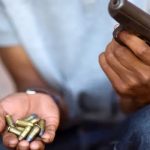The date was 6 May 2025. The scene: Phola Park Extension 5 in Thokoza, a town on the East Rand of Gauteng, South Africa. What started as a brazen cash-in-transit (CIT) heist quickly turned into a gruesome spectacle, leaving investigators piecing together not just a crime, but a human body.
For months, perhaps even years, a group of criminals had been meticulously planning their next big score: a cash van carrying untold riches. Their target was a Fidelity cash van, a vehicle designed to withstand attacks, but not impervious to the destructive power of modern explosives. The gang, numbering around ten, had a plan, a silver BMW, and a deadly arsenal.
Just after 8:00 AM, the quiet morning in Thokoza was shattered. The silver BMW, driven by one of the gang members, rammed head-on into the Fidelity cash van at the intersection of Khumalo and Murubisi streets. The impact brought the van to a screeching halt, setting the stage for the next phase of the operation.
Eyewitnesses later recounted seeing at least ten armed men jump out of the BMW and surrounding vehicles. They were heavily armed, their faces concealed, their intentions clear: to get their hands on the cash inside the van. But their plan was about to go horribly wrong.
One of the robbers, carrying live explosives, made a fatal move. He exited the vehicle, intending to plant the explosives on the cash van, a calculated act to breach its reinforced armour. But fate, or perhaps a miscalculation, intervened. The explosive device detonated prematurely.
The explosion was deafening. Residents nearby described the ground shaking, windows rattling, and a cloud of dust and debris filling the air. The force of the blast was immense, and the robber carrying the explosives bore the full brunt of it.
Investigators found fragments of human flesh on rooftops, in people's yards, and strewn across the streets. The scene was a macabre jigsaw puzzle, with forensic experts tasked with Collecting and identifying the dismembered remains. It was a gruesome task, one that would haunt them for years to come.
According to Gauteng Hawks spokesperson Colonel Katlego Mogale, the suspected robber's chopped body parts were found on roof tops of the neighbouring houses at the corner of Khumalo and Murubisi streets. Mogale said it was after police had arrived at the scene and the commotion had died down that residents started seeing mangled pieces of body parts in their yards and on the streets.
The discovery of the scattered remains left the Thokoza community shell-shocked. Residents who had initially rushed to the scene, drawn by the explosion and gunfire, were now confronted with the horrific aftermath. What they thought was a robbery gone wrong was, in fact, a scene of unimaginable carnage.
One resident recounted that the experience had been terrifying. The resident said that at first, it sounded like a crash, followed by gunshots, and then a massive explosion that shook their house. The resident added that when they looked outside, it was full of people, dust, and the van, and that they heard someone had lost their leg right there.
Another witness, a man who was doing maintenance nearby, described a white Volkswagen Golf GTI arriving at the scene, from which men emerged and opened fire. The witness stated that they appeared to be trying to assist with the heist, but after the bomb detonated and injured one of their own, they grabbed him and fled, failing to obtain any money.
Despite the chaos and the death of one of their own, the remaining members of the gang managed to escape. They fled the scene in three other vehicles, leaving behind the wrecked BMW and the dismembered remains of their comrade. The cash van, though damaged, remained intact, its precious cargo untouched.
Police spokesperson Captain Tintswalo Sibeko confirmed that no cash was stolen during the attempted robbery. Sibeko stated that the cash van had been rammed by a silver BMW, and preliminary investigations indicated that one suspect sustained a serious injury during the explosion. She also noted that the vehicle used in the ramming was left behind at the scene.
The failed heist and the death of the robber raised many questions. Who was this man who had died in such a violent manner? What motivated him to risk his life for money? And who were his accomplices?
Hawks investigators are now working to piece together the identity of the deceased robber and track down the remaining members of the gang. The pieces of human flesh found at the scene are being used to build a DNA profile of the suspect, which could provide crucial clues to his identity and connections.
Colonel Mogale stated that, to date, no one has come forward to claim the body parts. She indicated that if the remains go unclaimed, they would be buried in a pauper's funeral. She further explained that this situation underscores the danger of approaching a cash van that has been bombed to pick up money after the robbers have left, as other explosives might not have detonated yet.
The Thokoza incident has once again highlighted the growing problem of CIT heists in South Africa. These crimes are not only dangerous and violent, but they also have a devastating impact on communities.
KwaZulu-Natal has recorded the highest number of CIT robberies this year (34%), followed by Gauteng with 31%. CitaSA's Grant Clark noted that as of the beginning of May 2025, 80% of the CIT robberies were perpetrated in Gauteng.
While CitaSA is Collaborating with various role players to combat CIT heists through information sharing, crime risk identification, cutting-edge technology, and an offender-focused approach, the problem persists.
Clark emphasized that arresting and convicting the criminals is essential to winning the war against CIT heists. He warned that even if there is a decline in the number of heists, the robbers will continue to plan and execute new attacks if they are not brought to justice.
Police crime statistics show that 238 heists were recorded in 2021-to-2022 and 2022-to-2023. In 2023-to-2024, the number dropped to 211, a decrease of 27 incidents. However, the statistics do not tell the whole story. The violence and trauma associated with these crimes continue to plague communities across South Africa.
Dr Hennie Lochner, a senior lecturer in forensic and criminal investigation science at Unisa, believes that the police will not win the war against CIT heists unless the perpetrators are arrested and convicted. He explained that CIT groups are formed after a successful robbery, and the members then go their separate ways, each looking for a new target.
The Thokoza incident is a reminder of the dangers faced by those who transport cash and the lengths to which criminals will go to obtain it. It also highlights the need for a multi-faceted approach to combat CIT heists, including improved security measures, better intelligence gathering, and more effective law enforcement.
In the meantime, the Thokoza community is left to grapple with the aftermath of the failed heist and the gruesome death of the robber. The images of the severed leg and the scattered remains will likely linger in their minds for years to come. The incident has shattered their sense of security and left them wondering what the future holds.
As the investigation continues, one thing is clear: the war against Cash in transit heists in South Africa is far from over. And until the perpetrators are brought to justice, communities like Thokoza will continue to live in fear.

Follow Us on Twitter











